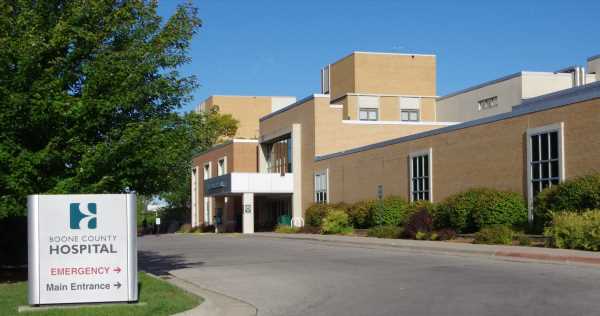Precision dosing improves patient safety for critical access hospital
Photo: Boone County Hospital
Traditional vancomycin dosing created several issues at Boone County Hospital in rural Iowa.
THE PROBLEM
Because Boone does not have 24-hour pharmacists on site, it was difficult to time troughs appropriately for a window when a pharmacist could be present to interpret the level and make dose adjustments.
“We also had some difficulties effectively communicating with our nursing staff and lab when a trough level was required, resulting in doses given early and troughs drawn at the inappropriate time or while vancomycin was running,” said Kimberly Askren, PharmD, in the pharmacy department at Boone County Hospital.
“As a critical access hospital, our goal is to keep patients admitted for less than four days,” she continued. “Previously, we had to wait until the patient achieved steady state concentration to check a level, which meant that we were either shooting blind or keeping people on IV antibiotics longer than was necessary until we could check a level.”
When the consensus guidelines were released promoting the utilization of area under the curve (AUC) to dose vancomycin, Boone County was presented with new challenges.
“The primary issue was a lack of experience with complex pharmacokinetic equations, with which we all had varying degrees of familiarity,” Askren explained. “The same issues as before also existed, which meant that now we would have to check two levels, coordinating effectively with nursing and lab to ensure the timing was appropriate while also working around limited pharmacist hours and staffing.
“If we managed to pull it all off, the pharmacist would still require a fair amount of time to calculate appropriate dosing and make adjustments, all while our busy days carried on around us,” she added. “We would still be waiting days to be able to determine whether empiric dosing was sufficient to treat the patient, or not. Sometimes, we might only find out that the initial dosing was excessive due to a sudden change in the patient’s kidney function.”
PROPOSAL
Vendor InsightRX offered Boone County numerous technologies to simplify the situation.
“We knew the company offered solutions to the issues of both trough- and AUC-based dosing that would allow us to achieve appropriate dosing much sooner,” Askren said. “As we would not have to wait until steady state to assess the patient’s levels, we could provide therapeutic doses from the beginning.
“We would no longer have delays in achieving adequate levels, or have as much risk of overdosing patients without realizing it,” she continued.
“The value and benefit of model-informed precision dosing software is huge, and it pays for itself rather quickly.”
Kimberly Askren, PharmD, Boone County Hospital
The software would allow staff to continue drawing just one level instead of two, and the timing could be flexible.
“This was a huge advantage for us, as it enabled us to save time and reduce costs for both the patients and our lab,” Askren explained. “We would be able to set our levels at a standard time so they could be drawn with morning labs, ensuring a pharmacist was available in the morning to address the level.
“This would increase efficiency for our lab, nursing staff and pharmacy, as well as reduce the number of blood draws and associated costs for the patient,” she continued.
Another advantage was the confidence that a precision dosing platform would give clinicians, she added.
“We could ensure that patients were treated appropriately and consistently by the various pharmacists who staff our hospital,” Askren noted. “Our staff have a wide range of skills and comfort levels with vancomycin dosing, and historically, dosing to a specific trough has been quite difficult.
“For example, even when we created a protocol to dose based on the patient’s weight and kidney function, we still found high variability in the outcomes achieved,” she continued. “By promoting consistency, this software would help Boone improve patient care, reducing the risk of overdosing, which leads to acute kidney injury, as well as the risk of underdosing, which leads to poor patient outcomes.”
MEETING THE CHALLENGE
Boone County Hospital implemented the InsightRX Nova software rather quickly and easily, Askren reported.
“The implementation required a quick communication with our lab staff, nurses and physicians, letting them know that we were switching from checking troughs to checking random levels,” she explained. “Otherwise, the entire project was kept within the pharmacy. All of our pharmacists were trained to use the software utilizing the company’s resources – demo training and their very complete how-to guide.
“Unfortunately, due to limitations with our EHR and the high cost of interfaces, our software is not integrated with any other systems,” she added. “However, the software requires minimal extra effort from the pharmacist to manually enter information. It still requires significantly less time than waiting on two levels and performing manual pharmacokinetic calculations.”
RESULTS
Boone County’s EHR software makes it difficult to track results like this, so the pre-implementation data is really lacking.
“However, a couple of notable achievements have been a cost avoidance of about $10,000-$15,000 per year in reduced lab draws just from doing one level instead of two levels,” Askren reported. “This savings does not even factor in the labor cost associated with having the lab personnel draw at the same time as morning labs, rather than having to come back at various times to draw specific vancomycin troughs.
“In our first full year using InsightRX Nova, we achieved a therapeutic vancomycin AUC only about half the time,” she continued. “The company sat down with me to review the data and provided some excellent clinical feedback, which we disseminated to our staff.”
The next year, staff increased their achievement of target AUC by 27%, up to 79%. They also dropped the percentage of patients experiencing an acute kidney injury after 48 hours from 8% to 0%.
“If the average nephrotoxicity event costs a hospital $25,000 per year – as of 2013 – this software is saving us about $50,000 to $75,000 per year,” Askren said. “We were able to achieve zero acute kidney injuries during 2021 while utilizing the software.”
ADVICE FOR OTHERS
“Explore your options and involve your stakeholders in this decision,” Askren advised. “We evaluated three different Bayesian analytics precision dosing vendors. In the end, we chose the one that provided the best customer service and the most user-friendly platform for our specific users.
“We also found a company that was willing to work with us within our limited resources as a critical access hospital,” she noted. “Do not assume this technology is out of your reach because of limited resources and costs. The value and benefit of model-informed precision dosing software is huge, and it pays for itself rather quickly.”
Twitter: @SiwickiHealthIT
Email the writer: [email protected]
Healthcare IT News is a HIMSS Media publication.
Source: Read Full Article




